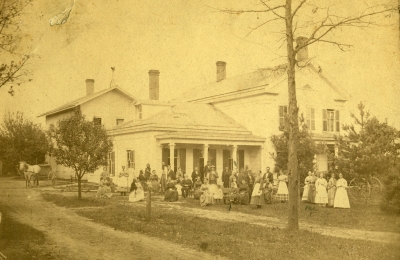1866-1871
To share the story of a people who lived to honor God by preventing and relieving human suffering.
(Ministry of Healing; Health Education)
History:
“The need for a health institution based on health principles newly advocated by the developing SDA Church was presented by Ellen White at the fourth session of the General Conference, which convened in Battle Creek, Michigan, in May 1866. It was decided to establish such an institution at Battle Creek, where the headquarters of the church were situated at that time. The site was considered to be midway between the East and the West, and easily accessible by means of the Michigan Central Railroad, which operated between Detroit and Chicago and ran through Battle Creek. The leaders of the church, among them James White and J. N. Loughborough, decided that the proposed institution should be organized as a stock company. In mid-June, an appeal to the people to subscribe to the stock was made in the Review and Herald. By that time the members of the church at Battle Creek and at Olcott, New York, had already subscribed more than $2,500, with J. P. Kellogg and James White heading the list with a subscription of $500 each. With these and other funds that came in, a residence with seven or eight acres (about three hectares) of land, situated in Battle Creek, was purchased from Benjamin Graves, a judge of the Michigan Superior Court. During that summer, a two-story addition was built and treatment rooms were equipped, allowing the institution to open for patients on Sept. 5, 1866, under the supervision of Dr. Horatio S. Lay. In less than two years, the stockholders voted to forgo any future profits in their investment and to tum any realized proceeds back to the hospital’s directors to use for charity.
“A note in the Review and Herald of Sept. 11 called attention to the rapidity with which the enterprise was conceived and carried out: ‘We have only to look back to our conference in May last, less than four short months ago, for the time when this matter first began to take practical shape among our people. Now we behold an elegant site secured, buildings ready for operation, a competent corps of assistants on the ground, … a sum bordering on $11,000 already subscribed for stock in the enterprise, and the institute opened and operations actually commenced. In no enterprise ever undertaken by this people has the hand of the Lord been more evidently manifested than in this thing’ (Review and Herald, 18: 116, Sept. 11, 1866).

Health Reform Institute
“The opening of the institution, named the Western Health Reform Institute, marked a new era in SDA history. The building was situated on high ground in Battle Creek, a flourishing manufacturing town of about 5,000 people. Screened from the street in front by a grove of trees, the institute looked out in the rear on a landscape of hill, valley, and stream. It was in a location suitable for inculcating the principles of right living as a means of recovering and preserving the health through the ‘correct application of water, the right use of air, and a proper diet.’ The equipment was meager but adequate for the immediate needs.
“Said M. E. Olsen, a later church historian: ‘It not only gave tangible outward expression to the health principles as a definite phase of denominational belief but it supplied an effective instrumentality for the propagation of those principles. It represented, on the side of the Adventists, a new and enlarged vision of the world’s need, and of the duty resting upon the Christian church to supply that need. The healing ministry of Christ was seen to be a manifestation of divine love which should be continued in the world through the instrumentality of the church. The practice of health principles and the use of simple hydropathic means of treating disease were regarded as a means of cooperating with the divine power, which alone can truly heal. Disease was seen to be the result of transgression of natural law; and the duty and privilege of Christians to obey all these laws, and teach others to obey them, appeared to be part of the everlasting gospel’ (Origin and Progress of Seventh-day Adventists, pp. 269, 270).
“When the pioneers of the SDA medical work decided to establish a corporation, they discovered that Michigan law had no provision for benevolent institutions of their kind. Consequently, the institute property was held in trust until the legislature could authorize the corporation (in an amendment to an act authorizing mining and manufacturing enterprises). The Western Health Reform Institute was legally incorporated on April 9, 1867. The unfortunate result of its incorporation under a law for business companies was the limiting of its charter to 30 years, a provision that later caused many difficulties over the administration and control of the institution and that eventually led to the separation of the sanitarium from the church.
“During the first 10 years, the institution had a struggle financially. James White, the leader in the enterprise, was away from his office much of the time, and also suffered from overwork. Without his business counsel, the institution came close to financial ruin. Furthermore, its medical staff, which at first did not represent the best medical schools, failed to inspire the public with confidence. Despite noble attempts on the part of the entire staff to carry on as best they could, attempts that on the whole were reasonably successful, the patronage wavered. However, fortunes changed after John Harvey Kellogg, M.D., a graduate of Belleview Hospital Medical College, New York City, joined the staff in 1875, and the next year was appointed medical superintendent of the institute. About the same time, James White returned to leadership of the enterprise. By 1877 increased patronage made the erection of another building necessary. In the same year, the institution was renamed the Medical and Surgical Sanitarium; however, it later was commonly called the Battle Creek Sanitarium. When someone remarked that the word “sanitarium” was not in the dictionary, Dr. Kellogg replied that it soon would be. Although the Battle Creek institution was not the first one in the world to use the word ‘sanitarium,’ it made the term well known, and for many years afterward SDA medical establishments were distinguished by this name. The Battle Creek institution soon became known affectionately as the “San” and gradually achieved an international reputation growing from its one patient status at its opening to 1200 patients and guests at the height of its fame in 1929. It has played an integral and lively part in two great histories-the beginning of both a worldwide medical ministry of the Seventh-day Adventist Church and of the cereal industry, which still is an important part of Battle Creek’s economy. ” – Excerpt from Seventh-day Adventist Encyclopedia, vol. 1 0, 1996 ed., pp. 173-175.
Building:
The building will be a replica of the original Western Health Reform Institute facility that opened in 1866 and that served in its current appearance until enlarged in 1871. There should be a full basement put under the replicated building that could be used for storage, mechanical equipment, and display area (if needed).
The first floor of the building will be made to appear as it would have between 1866 and 1871. The second floor will be used for displays. Among these might be displays contrasting other forms of medicine being practiced in the United States at the time this building was in operation, as well as possibly some interactive displays showing the scientific basis and long term impact for the health principles taught by Adventists.

